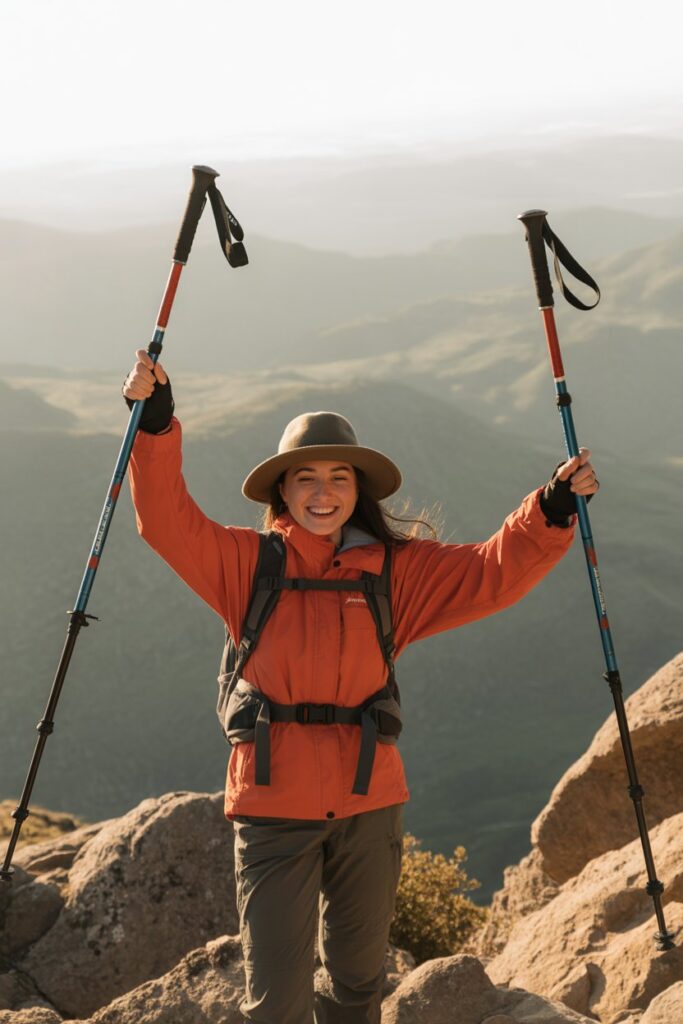If you’ve ever passed someone on a trail gliding along with trekking poles and thought “Wow, they look professional… but do I really need those?” – you’re not alone. Trekking poles often spark debate among hikers. Some swear by them, while others see them as unnecessary gear that just gets in the way. So, are trekking poles worth it? Let’s break it down trail-style – honest, practical, and a little fun.
What Do Trekking Poles Actually Do?
Think of trekking poles as an extra set of limbs that never get tired. They help you stay balanced, reduce impact on your joints, and give your arms something useful to do instead of just swinging by your side.
Here’s what they’re most helpful for:
- Stability on uneven terrain, river crossings, or rocky paths.
- Reducing knee strain during long descents.
- Extra power going uphill (hello, mini arm workout).
- Maintaining rhythm on flat, long trails.
- Multi-use gear: pitching a tarp, poking at questionable terrain, or fending off overly curious wildlife (looking at you, squirrels).
If you want the deep dive into technique, check out our guide on how to use trekking poles.
Are Trekking Poles Worth It for Every Hiker?
Not necessarily. Some hikers find them indispensable. Others try them once and leave them in the closet forever. The real question is whether you will benefit from them.
You’ll probably find trekking poles worth it if you:
- Hike on steep trails with lots of ups and downs.
- Have sensitive knees or ankles.
- Like long-distance treks or multi-day backpacking.
- Often hike in muddy, snowy, or unstable conditions.
- Carry a heavy pack and need the extra balance.
On the other hand, if you’re sticking to short, easy trails or just walking your local forest path, you may not notice a huge difference.
The Pros of Using Trekking Poles
Let’s be honest – trekking poles aren’t just hype. They bring some real advantages to your hikes.
- Joint protection: Studies show poles can reduce the force on your knees by up to 25%. That’s a big deal on long downhill sections.
- Better balance: Slippery log crossings or rocky scrambles feel less intimidating with extra points of contact.
- Energy efficiency: By spreading the effort between arms and legs, poles help you last longer on the trail.
- Upright posture: Poles encourage a straighter back and can prevent the hiker hunch.
- Multi-use tool: They’re not just for walking – many ultralight tents are designed to be pitched with trekking poles.
The Cons of Trekking Poles
It wouldn’t be fair to skip the downsides.
- Extra weight and bulk: Even lightweight poles take up space when not in use.
- Learning curve: If you don’t use them correctly, they can feel awkward.
- Trail etiquette: They can get in the way of other hikers on narrow trails.
- Added expense: Quality poles can cost $60 to $200.
In short – poles are an investment. But for many hikers, the benefits outweigh the drawbacks.
Are Trekking Poles Worth It for Beginners?
Yes – but with a caveat. Beginners often underestimate how challenging uneven trails can be. Poles give you confidence and security when everything feels new. They’re especially useful if you’re unsure about your balance or fitness level.
However, if you’re just starting with short, flat hikes, you might want to get comfortable with hiking basics first before adding extra gear.
Do Trekking Poles Help With Knee Pain?
Absolutely. This is probably the number one reason hikers swear by them. On long descents, poles absorb some of the shock that would normally hammer your knees. If you’ve ever ended a hike limping because your knees felt like jelly, trekking poles can be a game changer.
How to Choose the Right Trekking Poles
Not all trekking poles are created equal. You’ll want to consider:
- Material: Aluminum is durable but heavier. Carbon fiber is lighter but pricier.
- Locking system: Flick locks are quicker and more reliable than twist locks.
- Grip material: Cork grips mold to your hands and handle sweat well. Foam grips are soft but wear faster.
- Packability: Collapsible poles are easier to stash when not needed.
If you want to dig deeper into models, see our roundup of the best trekking poles of 2025.
Are Trekking Poles Worth It for Backpacking?
Yes – and arguably even more than day hikes. Backpacking means heavier loads and longer distances, which increase the strain on your body. Trekking poles not only help with stability, they can also replace tent poles for ultralight shelters. For anyone planning multi-day trips, they’re a smart addition to your gear list.
Do You Really Need Trekking Poles for Easy Trails?
Probably not. If your hikes are short, flat, and mellow, trekking poles might just feel like extra sticks in your hands. But here’s the thing: once you try them on a more challenging trail, you may never go back. Many hikers only realize how useful poles are after they don’t bring them and regret it halfway through a steep descent.
So, Are Trekking Poles Worth It?
The short answer: yes, for most hikers. If you value joint health, stability, and efficiency, they’re worth every penny. They might not be essential on every single trail, but they can transform tough hikes into enjoyable ones.
Think of them as an upgrade – like switching from sneakers to actual hiking boots. You can hike without them, but once you experience the difference, it’s hard to go back.
Take the Poles, Thank Yourself Later
At the end of the day, hiking is about enjoying the outdoors in a way that feels good for your body. Trekking poles are one of those pieces of gear that many hikers resist at first, then later call their secret weapon. If you’re curious, try borrowing a pair before you invest. Chances are, you’ll discover just how much they can change your experience.
So, are trekking poles worth it? If your knees, back, and balance could vote – they’d all shout yes.


